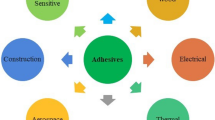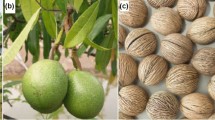Abstract
This study examined the effect of hemicellulose molecular structure on wettability and surface adhesion to urea–formaldehyde resin adhesives to better understand the complex adhesion process of wood biopolymers. Molecular structure of two hemicelluloses, such as arabinogalactan and xylan, was characterized using Fourier transform infrared, one-dimensional, and two-dimensional nuclear magnetic resonances. As a result, arabinogalactan had a hyperbranched structure, whereas xylan was more linear, which caused a distinctive morphology in their films, with the latter having a rougher surface. Further, the surface adhesion between hemicellulose and UF resins with various formaldehyde to urea molar ratios (1.0 and 1.6) was measured. The adhesion force and work of adhesion of arabinogalactan with different UF resins were found to be greater than those of xylan due to the former film’s higher surface free energy, more exposed OH groups, and smoother surface. In addition, 1.6 UF resins exhibited greater adhesion than 1.0 UF resins, regardless of the hemicellulose type, demonstrating that dispersion force was dominant in their molecular interactions.









Similar content being viewed by others
References
Ahola S, Salmi J, Johansson LS et al (2008) Model films from native cellulose nanofibrils preparation, swelling, and surface interactions. Biomacromol 9:1273–1282
Albornoz-Palma G, Ching D, Valerio O et al (2020) Effect of lignin and hemicellulose on the properties of lignocellulose nanofibril suspensions. Cellulose 27:10631–10647
Bian J, Peng F, Peng X-P et al (2012) Isolation of hemicelluloses from sugarcane bagasse at different temperatures: structure and properties. Carbohydr Polym 88:638–645
Brett CJ, Mittal N, Ohm W et al (2019) Water-induced structural rearrangements on the nanoscale in ultrathin nanocellulose films. Macromolecules 52:4721–4728
Carrick C, Pendergraph SA, Wågberg L (2014) Nanometer smooth, macroscopic spherical cellulose probes for contact adhesion measurements. ACS Appl Mater Interface 6:20928–20935
Cheng J, Wei C, Li W et al (2021) Structural characteristics and enhanced biological activities of partially degraded arabinogalactan from larch sawdust. Int J Biol Macromol 171:550–559
Cwikel D, Zhao Q, Liu C et al (2010) Comparing contact angle measurements and surface tension assessments of solid surfaces. Langmuir 26:15289–15294
Duchesne I, Hult E, Molin U et al (2001) The influence of hemicellulose on fibril aggregation of kraft pulp fibres as revealed by FE-SEM and CP/MAS 13C-NMR. Cellulose 8:103–111
Dunky M (1998) Urea–formaldehyde (UF) adhesive resins for wood. Int J Adhes Adhes 18:95–107
Ebringerová A, Heinze T (2000) Xylan and xylan derivatives - biopolymers with valuable properties, 1. naturally occurring xylans structures, isolation procedures and properties. Macromol Rapid Commun 21:542–556
Gao C, Ren J, Kong W et al (2015) Comparative study on temperature/pH sensitive xylan-based hydrogels: their properties and drug controlled release. RSC Adv 5:90671–90681
Goellner EM, Utermoehlen J, Kramer R, Classen B (2011) Structure of arabinogalactan from larix laricina and its reactivity with antibodies directed against type-II-arabinogalactans. Carbohydr Polym 86:1739–1744
Gustafsson E, Johansson E, Wågberg L, Pettersson T (2012) Direct adhesive measurements between wood biopolymer model surfaces. Biomacromol 13:3046–3053
Hollertz R, Arwin H, Faure B et al (2013) Dielectric properties of lignin and glucomannan as determined by spectroscopic ellipsometry and Lifshitz estimates of non-retarded Hamaker constants. Cellulose 20:1639–1648
Jakes JE, Zelinka SL, Hunt CG et al (2020) Measurement of moisture-dependent ion diffusion constants in wood cell wall layers using time-lapse micro X-ray fluorescence microscopy. Sci Rep 10:1–11
Jeong B, Park B-D (2019) Effect of molecular weight of urea–formaldehyde resins on their cure kinetics, interphase, penetration into wood, and adhesion in bonding wood. Wood Sci Technol 53:665–685
Joe J, Thouless MD, Barber JR (2018) Effect of roughness on the adhesive tractions between contacting bodies. J Mech Phys Solid 118:365–373
Kac̆uráková M, Capek P, Sasinková V et al (2000) FT-IR study of plant cell wall model compounds: pectic polysaccharides and hemicelluloses. Carbohydr Polym 43:195–203
Levendis D, Pizzi A, Ferg E (1992) The correlation of strength and formaldehyde emission with the crystalline/amorphous structure of UF resins. Holzforschung 46:263–269
Linder Å, Bergman R, Bodin A, Gatenholm P (2003) Mechanism of assembly of Xylan onto cellulose surfaces. Langmuir 19:5072–5077
Luner P, Sandell M (2007) The wetting of cellulose and wood hemicelluloses. J Polym Sci Part C Polym Symp 28:115–142
Myers D (1999) Surfaces, interfaces, and colloids. John Wiley, New York, USA
Nagel A, Conrad J, Leitenberger M et al (2016) Structural studies of the arabinogalactans in mangifera indica L. fruit exudate. Food Hydrocoll 61:555–566
Niu X, Liu Y, Fang G et al (2018) Highly transparent, strong, and flexible films with modified cellulose nanofiber bearing UV shielding property. Biomacromol 19:4565–4575
Notley SM, Norgren M (2010) Surface energy and wettability of spin-coated thin films of lignin isolated from wood. Langmuir 26:5484–5490
Nuryawan A, Park B-D, Singh AP (2014) Penetration of urea–formaldehyde resins with different formaldehyde/urea mole ratios into softwood tissues. Wood Sci Technol 48:889–902
Nypelö T, Asaadi S, Kneidinger G et al (2018) Conversion of wood-biopolymers into macrofibers with tunable surface energy via dry-jet wet-spinning. Cellulose 25:5297–5307
Pastewka L, Robbins MO (2014) Contact between rough surfaces and a criterion for macroscopic adhesion. Proc Natl Acad Sci 111:3298–3303
Peng P, Peng F, Bian J et al (2011a) Studies on the starch and hemicelluloses fractionated by graded ethanol precipitation from bamboo phyllostachys bambusoides f. shouzhu Yi. J Agric Food Chem 59:2680–2688
Peng XW, Ren JL, Zhong LX, Sun RC (2011b) Nanocomposite films based on xylan-rich hemicelluloses and cellulose nanofibers with enhanced mechanical properties. Biomacromol 12:3321–3329
Peng Y, Gardner DJ, Han Y (2012) Drying cellulose nanofibrils: in search of a suitable method. Cellulose 19:91–102
Pizzi A, Valenzuela J (1994) Theory and practice of the preparation of low formaldehyde emission uf adhesives. Holzforschung 48:254–261
Ponder GR, Richards GN (1997) Arabinogalactan from Western larch, part III: alkaline degradation revisited, with novel conclusions on molecular structure. Carbohydr Polym 34:251–261
Ramos A, Sousa S, Evtuguin DV, Gamelas JAF (2017) Functionalized xylans in the production of xylan-coated paper laminates. React Funct Polym 117:89–96
Saxena A, Elder TJ, Pan S, Ragauskas AJ (2009) Novel nanocellulosic xylan composite film. Compos Part B Eng 40:727–730
Sczech R, Riegler H (2006) Molecularly smooth cellulose surfaces for adhesion studies. J Colloid Interface Sci 301:376–385
Sharma K, Khaire KC, Thakur A et al (2020) Acacia Xylan as a substitute for commercially available Xylan and its application in the production of Xylooligosaccharides. ACS Omega 5:13729–13738
Sosa-Gil C, Babiano R, Cintas P et al (2021) On the anomeric preference of the isothiocyanato group. New J Chem. https://doi.org/10.1039/D1NJ00852H
Sun Y, Jiang Y, Choi C-H et al (2017) Direct Measurements of adhesion forces for water droplets in contact with smooth and Patterned polymers. Surf Innov 6:1–52
Synytsya A, Čopíková J, Matějka P, Machovič V (2003) Fourier transform raman and infrared spectroscopy of pectins. Carbohydr Polym 54:97–106
Tang S, Jiang M, Huang C et al (2018) Characterization of arabinogalactans from larix principis-rupprechtii and their effects on no production by macrophages. Carbohydr Polym 200:408–415
Tang S, Wang T, Huang C et al (2020) Arabinogalactans from larix principis-rupprechtii: an investigation into the structure-function contribution of side-chain structures. Carbohydr Polym 227:115354
Timell TE (1967) Recent progress in the chemistry of wood hemicelluloses. Wood Sci Technol 1:45–70
van Oss CJ (1993) Acid-base interfacial interactions in aqueous media. Colloid Surf A Physicochem Eng ASP 78:1–49
van Oss CJ (2006) Interfacial forces in aqueous media. CRC Press
van Oss CJ, Chaudhury MK, Good RJ (1988) Interfacial Lifshitz–van der Waals and polar interactions in macroscopic systems. Chem Rev 88:927–941
Velkova N, Doliška A, Fras Zemljič L et al (2015) Influence of carboxymethylation on the surface physical-chemical properties of glucuronoxylan and arabinoxylan films. Polym Eng Sci 55:2706–2713
Wang H, Cao M, Li T et al (2018) Characterization of the low molar ratio urea-formaldehyde resin with 13C NMR and ESI–MS: negative effects of the post-added urea on the urea-formaldehyde polymers. Polym (Basel) 10:602
Wang D, Jiang Y, Zhu Z et al (2020) Contact line and adhesion force of droplets on concentric ring-textured hydrophobic surfaces. Langmuir 36:2622–2628
Werner K, Pommer L, Broström M (2014) Thermal decomposition of hemicelluloses. J Anal Appl Pyrolysis 110:130–137
Wibowo ES, Park B-D (2021a) Direct measurement of surface adhesion between thin films of nanocellulose and urea–formaldehyde resin adhesives. Cellulose 28:8459–8481
Wibowo ES, Park B (2021b) Crystalline lamellar structure of thermosetting urea-formaldehyde resins at a low molar ratio. Macromolecules 54:2366–2375
Wibowo ES, Park B-D (2022) Two-dimensional nuclear magnetic resonance analysis of hydrogen-bond formation in thermosetting crystalline urea-formaldehyde resins at a low molar ratio. ACS Appl Polym Mater 4:1084–1094
Wibowo ES, Park B-D, Causin V (2020) Hydrogen-bond-induced crystallization in low-molar-ratio urea-formaldehyde resins during synthesis. Ind Eng Chem Res 59:13095–13104
Wibowo ES, Park B, Causin V (2021) Recent advances in urea–formaldehyde resins: converting crystalline thermosetting polymers back to amorphous ones. Polym Rev. https://doi.org/10.1080/15583724.2021.2014520
Wiercigroch E, Szafraniec E, Czamara K et al (2017) Raman and infrared spectroscopy of carbohydrates: a review. Spectrochim Acta Part A Mol Biomol Spectrosc 185:317–335
Willför S, Sjöholm R, Laine C, Holmbom B (2002) Structural features of water-soluble arabinogalactans from Norway spruce and scots pine heartwood. Wood Sci Technol 36:101–110
Wu J, Xu Y, Zhu B et al (2020) Characterization of an arabinogalactan from the fruit hulls of ficus pumila linn and its immunomodulatory effect. J Funct Food 73:104091
Zhang X, Chen M, Wang H et al (2015) Characterization of Xylan- graft -polycaprolactone copolymers prepared in ionic liquid. Ind Eng Chem Res 54:6282–6290
Zhong LX, Peng XW, Yang D et al (2013) Long-chain anhydride modification: a new strategy for preparing xylan films. J Agric Food Chem 61:655–661
Acknowledgements
This work was supported by the National Research Foundation of Korea funded by the Korean Government (MSIT) (Grant No. 2020R1A2C1005042).
Author information
Authors and Affiliations
Contributions
The manuscript was written through the contributions of both authors. Both the authors have given approval to the final version of the manuscript. Both the authors contributed equally to this manuscript.
Corresponding author
Ethics declarations
Conflict of interest
The authors declare no competing financial interest.
Additional information
Publisher's Note
Springer Nature remains neutral with regard to jurisdictional claims in published maps and institutional affiliations.
Supplementary Information
Below is the link to the electronic supplementary material.
Rights and permissions
About this article
Cite this article
Wibowo, E.S., Park, BD. Effect of hemicellulose molecular structure on wettability and surface adhesion to urea–formaldehyde resin adhesives. Wood Sci Technol 56, 1047–1070 (2022). https://doi.org/10.1007/s00226-022-01397-8
Received:
Accepted:
Published:
Issue Date:
DOI: https://doi.org/10.1007/s00226-022-01397-8




